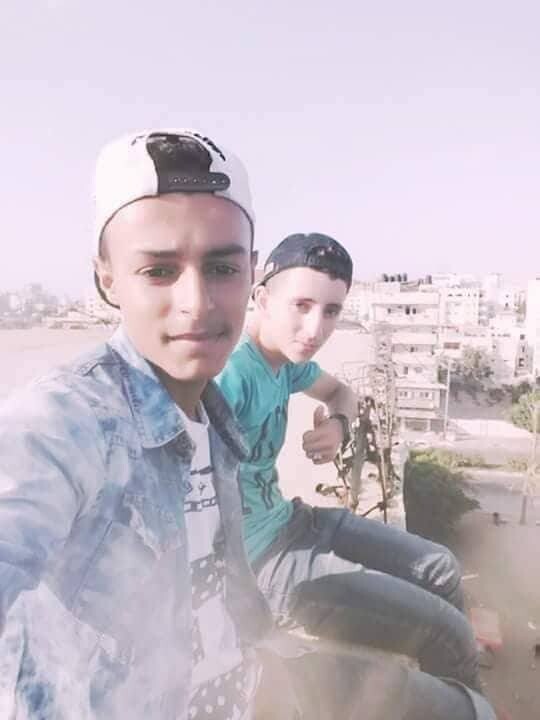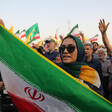Rights and Accountability 20 December 2018
Louay Kuhail and Amir al-Nimra, both aged 14, were sitting on the roof of an unfinished building in the al-Katiba quarter in the heart of Gaza City in the early evening of 14 July, as the area was full of children and families relaxing and seeking relief from the summer heat.
At 5:45pm, Israel fired the first of four so-called warning missiles at the roof of the building just as the boys had taken a selfie – the last photo of the two devoted friends alive.
That missile landed about nine meters away from the boys, lethally wounding both of them.

A selfie taken by Louay Kuhail, left, and Amir al-Nimra, shortly before they were killed in an Israeli strike on 14 July.
Israel followed the four warning missiles – a tactic it calls “roof-knocking” – with four much more powerful strikes, causing injuries to 23 other people and widespread damage, including to a mosque, a cultural center and Palestinian health ministry facilities.
As The Electronic Intifada’s Hamza Abu Eltarabesh reported, the Israeli attack turned what was normally an area for leisure and fun “into a place of horror.”
The Israeli military claims that its warning missiles are a “loud but non-lethal” means to give civilians time to escape before a much bigger and more lethal strike.
But a joint investigation by University of London-based multidisciplinary research group Forensic Architecture and the Israeli human rights group B’Tselem found that the munition that killed the boys was “likely an anti-personnel missile armed with lethal fragments.”
Their sophisticated analysis of video evidence and computer modeling is clearly explained in the video at the top of this article.
“Multiple weapons experts independently concluded that the fragmentation pattern” from the missile that killed the boys “is indicative of shrapnel specifically designed to increase the damage caused to human bodies,” the investigation states.
Hiding the crime
Hours after the attack on the unfinished al-Katiba building – which Israel claimed was being used by Hamas – the Israeli military tweeted a video, supposedly showing the four warning strikes, followed by the bigger bombs.
Multiple eyewitnesses reported that the two boys were killed by the first warning missile. But in the Israeli army footage, the boys are not visible on the roof as the missile strikes.This is because, as Forensic Architecture’s analysis shows, the video is doctored.
Instead of showing the four warning strikes in sequence, the Israelis substituted footage of the third warning strike in place of the first one, but using footage filmed from a different angle.
“Only three of the four warnings shots, then, are accounted for,” the investigation states. “There is a missing strike in the sequence.”
That is the one that killed the boys.
If the two boys were visible in the missing video, then they should not have been targeted, the investigation states. If, however, they were not visible, “it follows that the Israeli military cannot justifiably rely on its aerial surveillance technologies to avoid civilian casualties.”
“Civil society and the international community should be concerned not only by the violations of international humanitarian law that are inherent to the warning strike policy but also by the Israeli military’s attempt to obscure the harm of that policy by manipulating the truth of the killing of Louay Kuhail and Amir al-Nimra,” the investigation adds.
Policy of bombing “crowded areas”
“As evidenced by the lethal outcomes of the airstrikes in Operation Protective Edge in 2014, the military’s use of ‘warning missiles’ ahead of attacks is absurd,” B’Tselem says in its own findings on the case. “Firing a missile at the roof of a building cannot be considered a warning and is undeniably part of the strike itself.”
The killing of the two boys on 14 July is, according to B’Tselem, “another example of Israel’s policy of bombing and firing at crowded areas in the Gaza Strip,” implemented during the 2014 Gaza war in which more than one in every thousand residents in the territory was killed.
No one has ever been held accountable for those attacks, or for the strike that killed Louay and Amir.
“My life has been hell since my son was killed. I cry over him day and night. I can still hear his voice and delightful laugh, and see the smile he always wore,” Amir’s mother Maysoun al-Nimra told B’Tselem. “I was so looking forward to seeing him grow up. But Israel’s military planes bombed him.”
Louay’s family is also devastated.
“I had hoped that Louay would grow up and go abroad to study at university, but my dreams were cut short by his death,” his mother Maha said. “My life stopped when he was killed. I have no joy, and my heart is full of sadness and pain and wounds.”
No justice
A previous Forensic Architecture investigation used video and audio analysis and computer modeling to pinpoint the Israeli soldier who shot dead in cold blood 17-year-old Nadim Siam Nuwara on 15 May 2014, in the occupied West Bank village of Beitunia.
Another teen, 16-year-old Muhammad Abu al-Thahir, was shot dead at almost the same spot, the same day, in the same manner.
After a lengthy Israeli cover-up, Ben Dery, a combatant in Israel’s paramilitary Border Police, in April received a slap on the wrist for killing Nuwara.
Sentencing Dery to a mere nine months in prison, the judge described the gunman, who had against orders used live ammunition and then lied about it, as “an excellent police officer who was conscientious about orders.”
No one has ever been brought to justice for killing Abu al-Thahir.





Comments
the rubble of lies
Permalink tom hall replied on
Many thanks for this contribution. Condolences go out to the families of these two boys murdered by the IDF and buried before the world under a rubble of lies. The nine minute video presentation offers a model of concise forensic analysis, and is, if anything, understated in its conclusions. Perversely, we sometimes find ourselves debating the exact terms by which Israel is permitted to terrorize Palestinians. I've heard people disagree on the best method of warning victims they're about to be bombed, when the central point of discussion and action ought to be that the entire Zionist project is an exercise in illegitimate force.
Everything we see and hear today demonstrates why the BDS campaign deserves our support.
Another case for the Criminal Court in The Hague
Permalink Ben Alofs replied on
The despicable routine murder of Louay Kuhail and Amir al-Nimra by Israeli State Terrorism must not go unpunished. I hope that in future this forensic evidence will be used to bring charges against the pilots and the Israeli army. We owe it to these innocent boys.